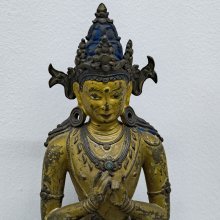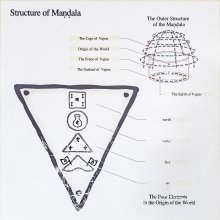Pancaskandha, Pañcaskandha, Pancan-skandha: 6 definitions
Introduction:
Pancaskandha means something in Buddhism, Pali, Hinduism, Sanskrit, Marathi. If you want to know the exact meaning, history, etymology or English translation of this term then check out the descriptions on this page. Add your comment or reference to a book if you want to contribute to this summary article.
Alternative spellings of this word include Panchaskandha.
Images (photo gallery)
In Buddhism
Mahayana (major branch of Buddhism)
Source: Wisdom Library: Maha Prajnaparamita SastraPañcaskandha (पञ्चस्कन्ध) refers to the “five elements”, according to Mahāprajñāpāramitāśāstra (chapter 4).—Accordingly, “[Question: Why is the Buddha called Sugata?]—[Answer]: [...] He alone knows who can be saved, who is sick or weakened, what each one needs to be saved, to whom it is suitable to preach generosity (dāna) or discipline (śīla) or nirvāṇa, to whom he can expound the system (dharma) of the five elements (pañcaskandha), the twelve causes (dvādaśa-hetupratyaya) or the four truths (caturāryasatya), etc., in order to introduce them into the Path. It is under aspects such as these that he knows the extent of knowledge (jñānabala) of his disciples and that, consequently, he preaches the doctrine. This is why he is called Sugata, well-spoken”.
Source: academia.edu: A Study and Translation of the GaganagañjaparipṛcchāPañcaskandha (पञ्चस्कन्ध) refers to the “five aggregates”, according to the Gaganagañjaparipṛcchā: the eighth chapter of the Mahāsaṃnipāta (a collection of Mahāyāna Buddhist Sūtras).—Accordingly, “Then, the Lord went on to speak these verses: ‘[...] (82) The dharma is taught in order to purify the five kinds of sight (pañcacakṣus), to illuminate the five kinds of abilities (pañcendriya), to eliminate the five states of existence (pañcagati), and to makes the five aggregates disappear (pañcaskandha). It is not dependent on this side nor that side, but established in the realm of the dharma, same as the sameness of the sky, and it exalts a being in accordance with the knowledge of the Buddha. [...]’”.

Mahayana (महायान, mahāyāna) is a major branch of Buddhism focusing on the path of a Bodhisattva (spiritual aspirants/ enlightened beings). Extant literature is vast and primarely composed in the Sanskrit language. There are many sūtras of which some of the earliest are the various Prajñāpāramitā sūtras.
Tibetan Buddhism (Vajrayana or tantric Buddhism)
Source: OSU Press: Cakrasamvara SamadhiPañcaskandha (पञ्चस्कन्ध) refers to the “five aggregates”, according to the Cakrasaṃvara Samādhi [i.e., Cakrasamvara Meditation] ritual often performed in combination with the Cakrasaṃvara Samādhi, which refers to the primary pūjā and sādhanā practice of Newah Mahāyāna-Vajrayāna Buddhists in Nepal.—Accordingly, “There, in the five aggregates (pañcaskandha), originates the making of I. Vairocana in the aggregate of forms. Vajrasūrya in sensations. Padmanṛtyeśvara in perceptions. Vajrarāja in mental formations. Vajrasattva in consciousness. Śrī Heruka Vajra in the truth of all Tathāgata”.

Tibetan Buddhism includes schools such as Nyingma, Kadampa, Kagyu and Gelug. Their primary canon of literature is divided in two broad categories: The Kangyur, which consists of Buddha’s words, and the Tengyur, which includes commentaries from various sources. Esotericism and tantra techniques (vajrayāna) are collected indepently.
General definition (in Buddhism)
Source: Wisdom Library: Dharma-samgrahaPañcaskandha (पञ्चस्कन्ध) refers to the “five components” as defined in the Dharma-saṃgraha (section 22):
- rūpa (bodily-form),
- vedanā (feelings),
- saṃjñā (perceptions),
- saṃskāra (volitions),
- vijñāna (consciousness).
The Dharma-samgraha (Dharmasangraha) is an extensive glossary of Buddhist technical terms in Sanskrit (e.g., pañca-skandha). The work is attributed to Nagarjuna who lived around the 2nd century A.D.
Languages of India and abroad
Marathi-English dictionary
Source: DDSA: The Molesworth Marathi and English Dictionarypañcaskandha (पंचस्कंध).—m pl S According to the philosophy of the saugata or bauddha sect. The five divisions or departments of human knowledge, viz. rūpa, vēdanā, vijñāna, sañjñā, saṃskāra. rūpa is expounded as viṣayaprapañca The expanse or world of objects--the sensible (but illusory) universe; vēdanā, as jñānaprapañca The world of perceptions or apprehensions, of impressions or affections by the viṣayaprapañca--the world of sensation; vijñāna, as ālayavijñānasantāna The world of these perceptions and impressions as a consecution or train, and this (illustrable by the multitude of succeeding waves--velut unda supervenit undam) swallowed up and lost in the last perception, --i.e. the ideas as successional and as perishing in the succession; sañjñā, as nāmaprapañca The congeries or system of designations or words to make known--the world of names; saṃskāra, as vāsa- nāprapañca The world of consciousness--the abiding or present consciousness of impressions and ideas passed utterly away and extinguished. 1 Cor. i.21.
Marathi is an Indo-European language having over 70 million native speakers people in (predominantly) Maharashtra India. Marathi, like many other Indo-Aryan languages, evolved from early forms of Prakrit, which itself is a subset of Sanskrit, one of the most ancient languages of the world.
Sanskrit dictionary
Source: Cologne Digital Sanskrit Dictionaries: Monier-Williams Sanskrit-English DictionaryPañcaskandha (पञ्चस्कन्ध):—[=pañca-skandha] [from pañca] ([in the beginning of a compound]) = dhī
Sanskrit, also spelled संस्कृतम् (saṃskṛtam), is an ancient language of India commonly seen as the grandmother of the Indo-European language family (even English!). Closely allied with Prakrit and Pali, Sanskrit is more exhaustive in both grammar and terms and has the most extensive collection of literature in the world, greatly surpassing its sister-languages Greek and Latin.
See also (Relevant definitions)
Partial matches: Skandha, Panca.
Starts with: Pancaskandhaka, Pancaskandhavimocaka.
Full-text (+7): Pancaskandhavimocaka, Pancaskandhaka, Pancaskantam, Five Components, Five Aggregates, Skandha, Vijnanatma, Vijnanasantati, Samjna, Panca, Vijnana, Vedana, Pancagati, Pancendriya, Caturaryasatya, Prajnapti, Prajnaptilakshana, Dvadasha, Catur, Gati.
Relevant text
Search found 9 books and stories containing Pancaskandha, Pañcaskandha, Pañca-skandha, Pancan-skandha, Panca-skandha, Pañcan-skandha; (plurals include: Pancaskandhas, Pañcaskandhas, skandhas). You can also click to the full overview containing English textual excerpts. Below are direct links for the most relevant articles:
Maha Prajnaparamita Sastra (by Gelongma Karma Migme Chödrön)
II.5. Dharma leading to the good place (aupanayika) < [II. Recollection of the Dharma (dharmānusmṛti)]
Part 6 - Why is the Buddha called Sugata < [Chapter IV - Explanation of the Word Bhagavat]
V.2 Generosity of the Dharma (dharmadāna) < [V. Recollection of abandonment (tyāgānusmṛti)]
Mahayana Buddhism and Early Advaita Vedanta (Study) (by Asokan N.)
A comparative study between Buddhism and Nyaya (by Roberta Pamio)
2. Vasubandhu and His Works < [Chapter 3 - The Buddhist Theory of Perception]
3.1. The Vaibhāṣika and the Sautrāntika School (Introduction) < [Chapter 2 - The Four Buddhist Schools of Philosophy]
Guhyagarbha Tantra (with Commentary) (by Gyurme Dorje)
Text 4.4 (Commentary) < [Chapter 4 (text and commentary)]
4b. Tantra-texts of the Māyājāla cycle < [Introduction]
Text 11.5 (Commentary) < [Chapter 11 (Text and Commentary)]
Bhesajjakkhandhaka (Chapter on Medicine) (by Hin-tak Sik)
Concepts of Health and Disease (In early Buddhism) < [Chapter 3 - Concepts of Health and Disease]

